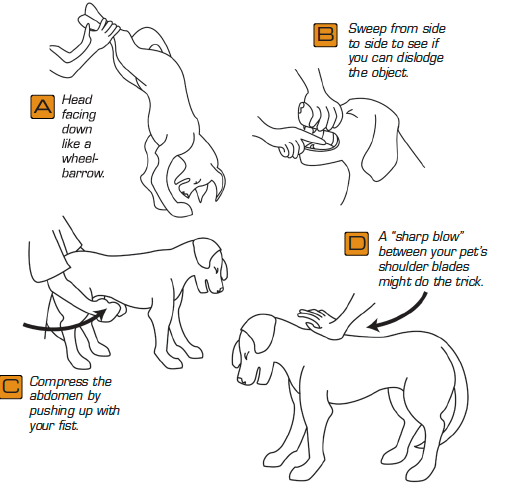
Video link: Heimlich Maneuver on small dogs
Most dogs will chew nearly anything: bones, toys, shoes, socks, etc. But would you know what to do if something became lodged in the windpipe or stuck on the palate and your dog began to choke? It's important that you do not wait for veterinary assistance, as the dog may suffocate.
What to Watch For
If the dog is suffocating, it will often panic. A dog may paw at its mouth if something is lodged, though this does not necessarily mean it is choking. Another suspicious sign of choking is an unresponsive or unconscious dog; in these cases, check the throat and mouth for foreign objects.
Primary Cause
Almost any small object can cause choking, though the most common are hard rubber balls, lumps of gristle, and chew toys or sticks that have become swollen due to moisture.
Immediate Care
Be very careful when dealing with a choking dog, as even calm animals will panic when they cannot breathe. Protect yourself by restraining the dog, but do not muzzle it.
- Use both hands to open the mouth, with one hand on the upper jaw and the other on the lower.
- Grasping the jaws, press the lips over the dog’s teeth so that they are between the teeth and your fingers.
- Look inside the mouth and remove the obstruction with your fingers.
- If you can’t move the object with your fingers, use a flat spoon handle to pry it away from the teeth or roof of the mouth.
If the dog is still choking and you can’t see anything in the mouth, or the dog has fallen unconscious, follow these guidelines.
For a SMALL Dog
Pick the dog up by its thighs and gently shake and swing it. If his condition does not improve, apply forward pressure to the abdomen just behind the ribcage.
For a LARGE Dog
Do not try to pick up, shake, or swing a large dog; you're more likely to do further damage due to the animal's size. Instead, perform the equivalent of the Heimlich maneuver:
- If the dog is standing, put your arms around her belly, joining your hands. Make a fist and push firmly up and forward, just behind the rib cage. Place the dog on his side afterward.
- If the dog is lying down, place one hand on the back for support and use the other hand to squeeze the abdomen upwards and forwards.
- Check the dog's mouth and remove any objects that may have been dislodges with your fingers.
Note that the object might be quite a way back towards the throat, so you might have to hunt around and hook it out with your index finger. If the dog required artificial respiration or CPR, seek immediate veterinary attention.
Veterinary Care
It is likely objects stuck in the throat have caused damage. Depending on the length of time the dog was without oxygen and the damage to the throat, the dog may require hospitalization for a few days. In some cases, bronchoscopy (whereby a small camera is inserted into the windpipe to visualize and remove the foreign body) may be recommended.
Although this may just be minor scratching, it is still important that a veterinarian examine the dog for potential problems. Sometimes foreign bodies stuck in the esophagus such as bones can cause respiratory distress and mimic choking.
Prevention
The best way to prevent choking is to treat your dog as you would a small child. Although it’s almost impossible to stop them putting things in their mouth, you should always be present and keep an eye on what they’re chewing. Avoid moisture-swollen chew toys or sticks, and cut up large chunks of food, especially gristle. T-bones are also known to cause choking when given to dogs.